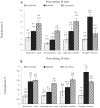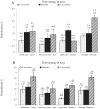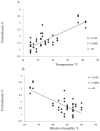Content of the Saponin Protodioscin in Brachiaria spp. from the Eastern Plains of Colombia
- PMID: 28703748
- PMCID: PMC5535167
- DOI: 10.3390/toxins9070220
Content of the Saponin Protodioscin in Brachiaria spp. from the Eastern Plains of Colombia
Abstract
Protodioscin is used as a marker of saponin content that could cause hepatotoxicity in ruminants. In Brachiaria spp. from two regions of the Colombian Eastern Plains (east mountain range of the Andean-"piedemonte" and Ariari River Valley) were determined this metabolite at 14 and 28 days post-cutting under different climatic conditions. No protodioscin was detected in B. dictyoneura or B. humidicola. In B. brizantha, B. decumbens and B. ruziziensis x B. decumbens x B. brizantha (hybrid), protodioscin content corresponded to an interaction between species, post-cutting time and season. Concentrations ≥1% (minimum toxic level) were recorded in B. decumbens and the hybrid, and to a lesser extent in B. brizantha. The concentration of protodioscin was higher at 28 days, when the pastures are suitable for consumption. B. brizantha accumulated the lowest saponin concentration, whereas the hybrid had the highest levels, particularly in the "piedemonte" and during drought (3.37%). Dry season favored the protodioscin concentration in B. decumbens (in river valley) and in the hybrid (in "piedemonte"). In the latter, there was a positive correlation with temperature and a negative with humidity, which are typical characteristics of dry periods. This is the first report of protodioscin content in the hybrid.
Keywords: Brachiaria spp.; Colombian eastern plains; protodioscin; saponin.
Conflict of interest statement
The authors declare no conflict of interest.
Figures





References
-
- ICA (Instituto Colombiano Agropecuario) Censo Pecuario Nacional 2016. [(accessed on 24 September 2016)]; Consolidado por Especies. Available online: http://www.ica.gov.co/getdoc/8232c0e5-be97-42bd-b07b-9cdbfb07fcac/Censos....
-
- WWF (World Wild Foundation) Tropical and Subtropical Grasslands, Savannas and Shrublands. Nothern South America in Colombia and Venezuela. [(accessed on 9 June 2017)]; Available online: https://www.worldwildlife.org/ecoregions/nt0709.
-
- Argell P., Keller-Grein G. Regional experience with Brachiaria: Tropical America-Humid Lowlands. In: Miles B.L., Maass C.B., editors. Brachiaria: Biology, Agronomy and Improvement. CIAT-EMBRAPA; Cali, Colombia: 1996. pp. 205–224.
-
- Lozano M., Doncel B., Moreno C. Manual de Plantas Tóxicas Para Bovinos. Región Llanos Orientales de Colombia: Meta y Casanare. Universidad Nacional de Colombia; Bogotá, Colombia: 2011. p. 60.
-
- Diaz G. Plantas Tóxicas de Importancia en Salud y Producción Animal en Colombia. Editorial UN Universidad Nacional de Colombia; Bogotá, Colombia: 2010. pp. 154–177.
Publication types
MeSH terms
Substances
LinkOut - more resources
Full Text Sources
Other Literature Sources
Miscellaneous

